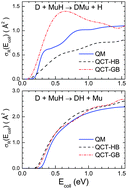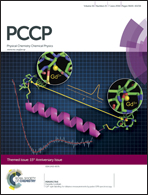Comparative dynamics of the two channels of the reaction of D + MuH
Abstract
The dynamics of the asymmetric D + MuH (Mu = Muonium) reaction leading to Mu exchange, DMu + H, and H abstraction, DH + Mu, channels has been investigated using time-independent quantum mechanical (QM) calculations. Reaction probabilities, cross sections, cumulative reaction probabilities, and rate coefficients were determined for the two exit channels of the reaction. Quasiclassical trajectory (QCT) calculations were also performed in order to check the reliability of the method for this reaction and to discern the genuine quantum effects. Overall, the Mu exchange channel exhibits more structured reaction probabilities and cross sections with much larger rate coefficients than the H abstraction counterpart. Over the 100–1000 K temperature interval considered in this study, the QM rate coefficients for the Mu exchange vary between ≈5 × 10−15 and 2 × 10−11 cm3 s−1 and those for the generation of DH + Mu between 2 × 10−18 and 3.5 × 10−12 cm3 s−1. In common with the rest of the isotopologues of the H + H2 system, the height of the respective barriers in the collinear (symmetric stretch) vibrationally adiabatic potential energy curves matches the classical total energy threshold very accurately. Indeed, the lower and narrower vibrationally adiabatic collinear barrier as compared with that for the DH + Mu formation determines the preponderance of the DMu + H channel. Comparison of QM and QCT results and their analysis show that tunneling accounts for the reactivity at energies below the height of these barriers and that its effect on the rate coefficients becomes appreciable below 300 K. As expected, with growing temperature the contribution of tunneling to the global reactivity decreases markedly, but the rate coefficients are still much higher for the Mu exchange channel due to the effect of MuH rotational excitation that boosts the formation of DMu while diminishing the H abstraction channel that leads to DH formation. The analysis of the thermal cumulative reaction probabilities of the two channels indicates that at the lowest energies/temperatures the reaction into the DH + Mu channel takes place via ‘leakage’ from collisions proceeding along the DMu + H reaction path.

- This article is part of the themed collection: PCCP’s 15th anniversary

 Please wait while we load your content...
Please wait while we load your content...